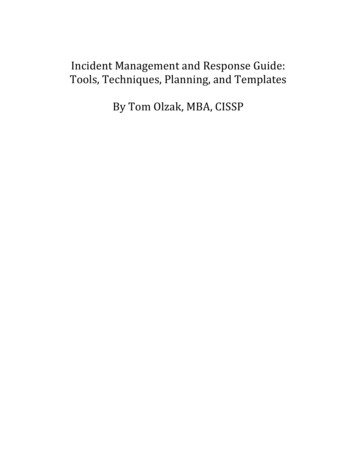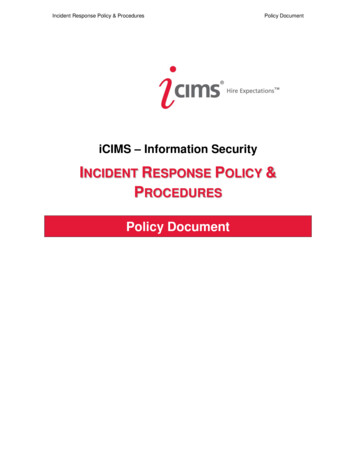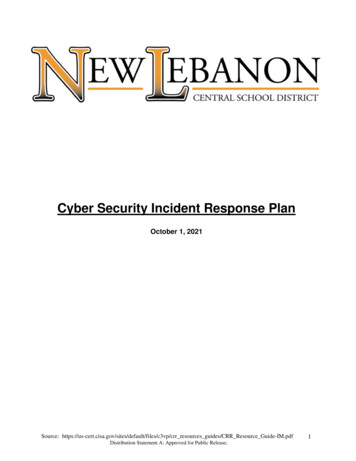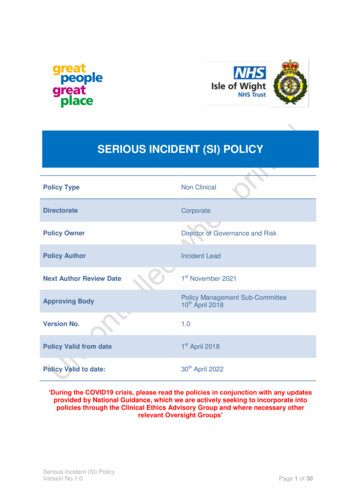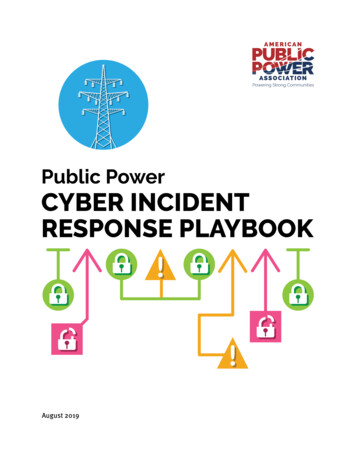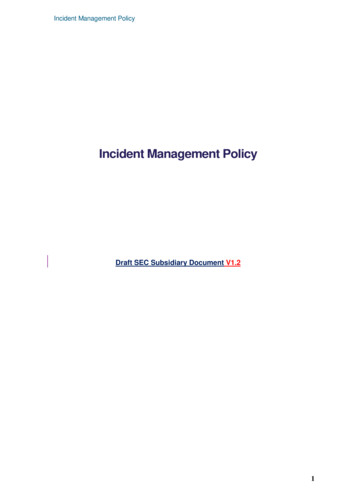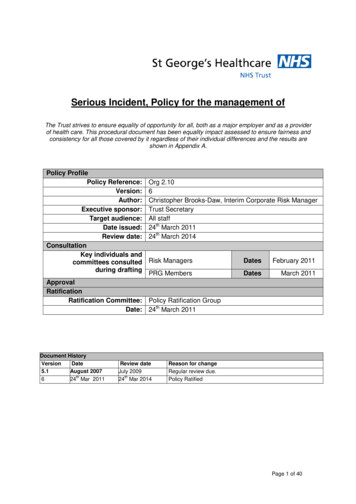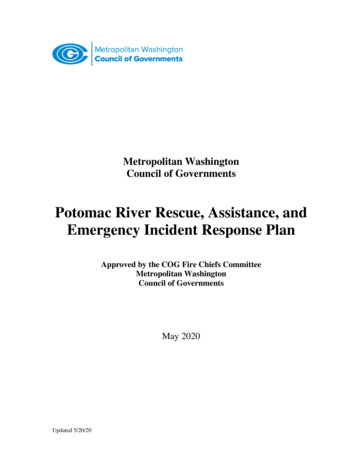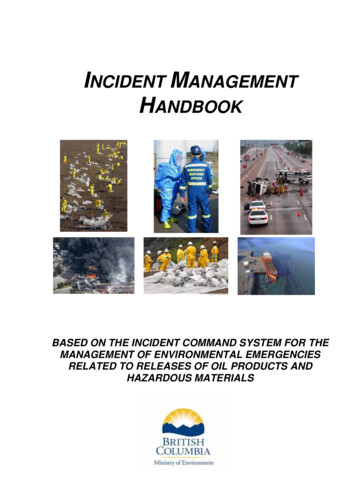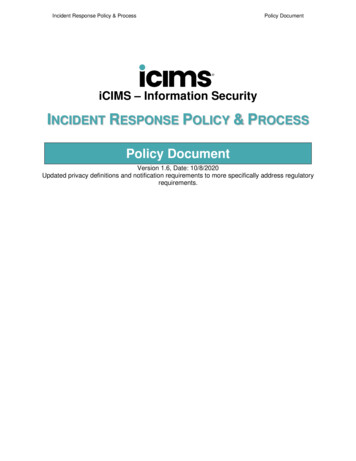
Transcription
Incident Response Policy & ProcessPolicy DocumentiCIMS – Information SecurityINCIDENT RESPONSE POLICY & PROCESSPolicy DocumentVersion 1.6, Date: 10/8/2020Updated privacy definitions and notification requirements to more specifically address regulatoryrequirements.
Incident Response ProceduresProcess Document1. DOCUMENT PURPOSE1.1. This document defines the policy for addressing Security and Privacy Incidents throughappropriate Incident Response.1.2. This document applies to all Personnel and supersedes all other policies relating to thematters set forth herein.2. TERMS & DEFINITIONSTerm/AcronymDefinitionData BreachA Security or Privacy Incident leading to the accidental or unlawful destruction, loss,alteration, unauthorized disclosure of, or access to, PII or Personal Data transmitted,stored or otherwise processed.Means the person or organization that determines the purpose and means of theProcessing of Personal Data.The engagement of additional resources to resolve or provide the status regarding anincident.Process for detecting, reporting, assessing, responding to, dealing with, and learningfrom Security Incidents.Preservation of confidentiality, integrity, and availability of Information and theequipment, devices or services containing or providing such Information.Means any information relating, directly or indirectly, to an identified or identifiabledata subject or individual, where such information is protected under applicable dataprotection or privacy law.Any information that (a) can be used to identify the PII principal or individual to whomsuch information relates, or (b) is or might be directly or indirectly linked to a PIIprincipal or individual.iCIMS employees (part and full time) and interns.Data ControllerEscalationIncident ResponseManagementInformation Security/IncidentPersonal rivacy EventPrivacy IncidentSecurity EventSecurity IncidentSecurity Incident Response Team(SIRT)Security VulnerabilitySecurity WeaknessA situation where PII or Personal Data is potentially processed in violation of one ormore relevant privacy principles under iCIMS’ internal privacy policies or procedures.A situation where PII or Personal Data is processed in violation of one or more relevantprivacy principles under iCIMS’ internal privacy policies or procedures.An identified occurrence of a system, service or network state indicating a possiblebreach of information security policy, a possible exploitation of a Security Vulnerabilityor Security Weakness or a previously unknown situation that can be security relevant.A single or series of unwanted or unexpected Security Events that compromisebusiness operations with an impact on Information Security.A predefined group of individuals needed and responsible for responding to anincident, managed by the Information Security Department. During an incident, theSIRT is responsible for communication with and coordination of other internal andexternal groups.A weakness of an existing asset or control that can be exploited by one or morethreats.A weakness that results from the lack of an existing, necessary control.
Incident Response ProceduresProcess Document3. SCOPEThe objective of this policy is to ensure a consistent and effective approach to the managementof Security and Privacy Incidents, including the identification and communication of Security andPrivacy Events and Security Weaknesses.4. INCIDENT RESPONSE POLICYThe Incident Response policy is as follows: Management responsibilities and procedures should be established to ensure a quick,effective, and orderly response to Security Incidents. The objectives for Security Incident management should be agreed upon withmanagement, and it should be ensured that those responsible for Security Incidentmanagement understand the organization’s priorities for handling Security Incidents. Security Events should be reported through appropriate management channels as quicklyas possible. Personnel and contractors using the organization’s information systems and services arerequired to note and report any observed or suspected Security Weakness or Vulnerabilityin systems or services. Security and Privacy Events should be assessed, and it should be decided if they are tobe classified as Security or Privacy Incidents. Security and Privacy Incidents should be responded to in accordance with documentedIncident Response procedures. Knowledge gained from analyzing and resolving Security and Privacy Incidents should beused to reduce the likelihood or impact of future incidents. Procedures should be defined and applied for the identification, collection, acquisition, andpreservation of information, which can serve as evidence. Awareness should be provided on topics such as:ooooThe benefits of a formal, consistent approach to Incident Management (personaland organizational);How the program works, expectations;How to report Security and Privacy Incidents, who to contact;Constraints imposed by non-disclosure agreements. 2013 iCIMS, Inc. All rights reserved.
Incident Response Procedures Communication channels should be established well in advance of a Security or PrivacyIncident. Include all necessary parties in relevant communication:ooo Process DocumentSIRT membersSenior ManagementiCIMS PersonnelIn the event a Security or Privacy Incident, Data Controllers, government bodies and othernecessary parties should be notified in a reasonable timeframe, and in compliance withregulatory and other applicable requirements and guidance.At no time should investigations into security or privacy events or incidents beunreasonably obstructed.o Any obstruction of an investigation into a security or privacy event or incident mustimmediately be reported to senior leadership for resolution.o Obstruction of an investigation may result in disciplinary action, up to and includingtermination. 2013 iCIMS, Inc. All rights reserved.
Incident Response ProceduresProcess DocumentiCIMS – Information SecurityINCIDENT RESPONSE PROCEDURESProcess DocumentVersion 2.6, Date 10/8/2020 2013 iCIMS, Inc. All rights reserved.
Incident Response ProceduresI.Process DocumentContents1.Document Purpose . 12.Terms & Definitions . 13.Scope . 24.Overview . 24.1.Roles and Responsibilities . 24.2.Detection Phase . 44.3.Analysis Phase . 74.4.Containment Phase . 104.5.Eradication Phase . 124.6.Recovery Phase . 134.7.Post-Incident Activities . 14II.Communications .14A.Notification . 14B.Cooperation with External Investigators . 15C.Information Sharing and Media Relations . 16D.External Incident Communications . 16E.Internal Incident Communications . 17III.A.Follow Up .17Retention and Review of Security or Privacy Incident Record & Documentation. 18Review of the incident record and documentation shall include the following:.19B.Retention and Review of Data Breaches Record & Documentation . 19C.Periodic Evaluation of the Program . 20 2013 iCIMS, Inc. All rights reserved.
Incident Response ProceduresProcess Document5. DOCUMENT PURPOSE1.3.The purpose of this document is to define the Incident Response procedures followedby iCIMS in the event of a Security and Privacy Incident. This document is a step-bystep guide of the measures Personnel are required to take to manage the lifecycle ofSecurity and Privacy Incidents within iCIMS, from initial Security and Privacy Eventand Incident recognition to restoring normal operations. This process will ensure thatall such Security and Privacy Incidents are detected, analyzed, contained anderadicated, that measures are taken to prevent any further Security and PrivacyIncidents, and, where necessary or appropriate, that notice is provided to Personnel,and/or affected parties and law enforcement authorities, if necessary.1.4.This document applies to all Personnel and supersedes all other procedures,practices, and guidelines relating to the matters set forth herein.6. TERMS & DEFINITIONSTerm/AcronymDefinitionAbnormal ActivitiesUnsuccessful attacks that appear particularly significant based on iCIMSunderstanding of the risks it faces.A Security or Privacy Incident leading to the accidental or unlawful destruction, loss,alteration, unauthorized disclosure of, or access to, PII or Personal Data transmitted,stored or otherwise processed.Means the person or organization that determines the purpose and means of theProcessing of Personal Data.The engagement of additional resources to resolve or provide the status regarding anincident.General Counsel’s OfficeCreated at the time a Security or Privacy Incident is initially recognized. Contains allrelevant information pertaining to the Security or Privacy Incident.Process for detecting, reporting, assessing, responding to, dealing with, and learningfrom incidents.Preservation of confidentiality, integrity, and availability of information and theequipment, devices or services containing or providing such Information.Means any information relating, directly or indirectly, to an identified or identifiabledata subject or individual, where such information is protected under applicable dataprotection or privacy law.Any information that (a) can be used to identify the PII principal or individual to whomsuch information relates, or (b) is or might be directly or indirectly linked to a PIIprincipal or individual.iCIMS employees (part and full time) and interns.Data BreachData ControllerEscalationGCOIncident RecordIncident ResponseManagementInformation Security/IncidentPersonal rivacy EventPrivacy IncidentSecurity or Privacy EventSecurity or Privacy IncidentSecurityorPrivacyResponse Team (SIRT)IncidentSensitive Personal Information (SPI)Security VulnerabilityA situation where PII or Personal Data is potentially processed in violation of one ormore relevant privacy principles under iCIMS’ internal privacy policies or proceduresA situation where PII or Personal Data is processed in violation of one or more relevantprivacy principles under iCIMS’ internal privacy policies or procedures.An identified occurrence of a system, service or network state indicating a possiblebreach of information security policy, a possible exploitation of a Security Vulnerabilityor Security Weakness or a previously unknown situation that can be security relevant.A single or series of unwanted or unexpected Security or Privacy Events thatcompromise business operations with an impact on Information Security.A predefined group of individuals needed and responsible for responding to anincident, managed by the Information Security Department. During an incident, theSIRT is responsible for communication with and coordination of other internal andexternal groups.A form of Personal Data and means any information revealing a Data Subject’sgenetic or biometric data, racial or ethnic origin, political opinions, religious orphilosophical beliefs, trade union membership, sexual orientation and lifestyle, orcriminal convictions or offensesA weakness of an existing asset or control that can be exploited by one or morethreats.Page 1
Incident Response ProceduresProcess DocumentTerm/AcronymDefinitionSecurity WeaknessA weakness that results from the lack of an existing, necessary control.Subscriber DataRefer to iCIMS Subscription Agreement.7. SCOPEThis document covers the Incident Response process for all identified Security and PrivacyIncidents. This incident response process is based off 800-61 Rev. 2.The following activities will be covered: Detection Analysis Containment Eradication Recovery Post-Incident ActivitiesThe Incident Response process is considered complete once Information confidentiality, integrity,and/or availability are restored to normal and verification has occurred.8. OVERVIEW8.1.Roles and ResponsibilitiesIndividuals needed and responsible for responding to a Security or Privacy Incident make upthe SIRT. Core members will include the following: CISO, Senior Director (SIRT Primary Lead) AVP, Legal & Compliance, Deputy General Counsel (SIRT Secondary Lead) Data Protection Officer (DPO) Security team staff Privacy team staff Information ownerOther groups and/or individuals that may be needed include: Senior Leadership General Counsel’s Office (GCO) Human Resources (Talent) End User Support ISS or Labs StaffPage 2
Incident Response ProceduresProcess Document Building and/or facilities management staff Other Personnel involved in the Security or Privacy Incident or needed forresolution Contractors (as necessary) Communications ResourcesPage 3
Incident Response ProceduresProcess DocumentProcess8.2.Detection PhaseIn the detection phase the SIRT, or an internal or external entity, identifies a Security orPrivacy Event that may be the result of a potential exploitation of a Security Vulnerability or aSecurity Weakness, or that may be the result of an innocent error.Immediately upon observation or notice of any suspected Security or Privacy Event,Personnel shall use reasonable efforts to promptly report such knowledge and/or suspicion tothe Information Security Department at the following address: Email: InformationSecurity@icims.comA Privacy Event shall also be reported to the following address: Email: privacy@icims.comA Security or Privacy Event may be discovered in many ways, including the following: Observation of suspicious behavior or unusual occurrences; Lapses in physical or procedural security; Information coming into the possession of unauthorized Personnel or Third Parties; Information inappropriately exposed on a publicly facing website.To assess whether a Security or Privacy Event must be reported, Personnel shall considerwhether there are indications that: Information was used by unauthorized Personnel or Third Parties;Page 4
Incident Response ProceduresProcess Document Information has been downloaded or copied inappropriately from iCIMS'scomputer systems or equipment; Equipment or devices containing Information have been lost or stolen; Equipment or devices containing Information have been subject to unauthorizedactivity (e.g., hacking, malware). Personal Data has been inappropriately disclosed, accessed or transferred.In addition, the following situations shall be considered for Security or Privacy Event reporting: Ineffective security controls; Breach of information integrity, confidentiality or availability expectations; Human errors (innocent or otherwise); Non–compliance with policies or standards; Breaches of physical security arrangements; Uncontrolled systems changes; Malfunctions of software or hardware; Access violations.Even if Personnel are not sure whether a Security or Privacy Event is an actual Security orPrivacy Incident, they are still required to report it as provided herein, as it is better to becautious than to be compromised.The SIRT will usually require the reporter to supply further information, which will depend uponthe nature of the Security or Privacy Event. However, the following information normally shallbe supplied: Contact name and information of person reporting the Security or Privacy Event; Date and time the Security or Privacy Event occurred or was noticed; Type and circumstances of the Security or Privacy Event; The type of data, information, or equipment involved; Location of the Security or Privacy Event, data or equipment affected; Whether the Security or Privacy Event puts any person or other data at risk; and Any associated ticket numbers, emails or log entries associated with the Securityor Privacy Event.SIRT Primary Lead will ensure that the SIRT is promptly engaged once such notice isreceived. The following actions will also be taken:1. The SIRT, under the leadership of the SIRT Primary Lead, shall use reasonableefforts to analyze the matter within four (4) hours of notice and decide whether toPage 5
Incident Response ProceduresProcess Documentproceed with the Analysis Phase of the Incident Response Procedures.a. Determination to initiate the Analysis Phase must be made quickly sothat Personnel can make an initial determination as to the urgency andseriousness of the situation.2. Upon making the decision to begin the Analysis Phase, if the SIRT suspects thatthe Security or Privacy Event may result in damage to the reputation of iCIMS orlegal liability, the GCO shall initiate a legal assessment of actual or potential legalissues.Page 6
Incident Response Procedures8.3.Process DocumentAnalysis PhaseThe initial response to detection of a Security or Privacy Event is typically the Analysis Phase.In this phase the SIRT determines whether a Security or Privacy Event is an actual Securityor Privacy Incident. To determine if a Security or Privacy Event is a Security or PrivacyIncident the following considerations apply:1. Leverage diagnostic data to analyze the Security or Privacy Event using toolsdirectly on the operating system or application. This may include, but not be limitedto:(i) Taking screenshots, memory dumps, consult logs and network traces;(ii) Performing analysis on the information being collected;(iii) Analyzing the precursors and indications;(iv) Looking for correlating information; and(v) Performing research (e.g., search engines, knowledgebase).2. Identify whether the Security or Privacy Event was the result of an innocent error,or the actions of a potential attacker. If the latter, effort shall be made to identifywho the potential attacker may be, by:(i) Validating the attacker's IP address;(ii) Researching the attacker through search engines;(iii) Using incident databases;(iv) Monitoring attacker communication channels, if possible; and(v) In unique cases, and with the approval of legal counsel, potentiallyscanning the attacker's system.If the SIRT has determined that a Security or Privacy Event has triggered a Security or PrivacyIncident, the appropriate SIRT team members will be engaged accordingly and the SIRT willbegin documenting the investigation and gathering evidence. The type of Security or PrivacyIncident is based on the nature of the event. Example types are listed as follows:1. Data exposure.2. Unauthorized access/Inappropriate role-based access.3. Distributed Denial of Service/ Denial of Service (DDoS/DoS).4. Malicious code.5. Improper usage.6. Scans/Probes/Attempted access.If it is determined that a Security or Privacy Incident has not been triggered, additionalactivities noted under ‘5.6. Post-Incident Activities’ may be initiated under the direction of theSIRT.Page 7
Incident Response ProceduresProcess DocumentThe Security or Privacy Incident’s potential impact on iCIMS and/or its Subscribers shall beevaluated and the SIRT shall assign an initial severity classification of low, medium, high orcritical to the Security or Privacy Incident. To analyze the situation, scope, and impact, theSIRT shall:1. Define and confirm the severity level and potential impact of the Security or PrivacyIncident.2. Identify which resources have been affected and forecast which resources will beaffected.3. Estimate the current and potential effect of the Security or Privacy Incident.The SIRT shall attempt to determine the scope of the Security or Privacy Incident and verifyif the Security or Privacy Incident is still ongoing. Scoping the Security or Privacy Incident mayinclude collecting forensic data from suspect systems or gathering evidence that will supportthe investigation. It may also include identifying any potential data theft or destruction. Newinvestigative leads may be generated as the collected data is analyzed. If the Security orPrivacy Incident involves malware, the SIRT shall analyze the malware to determine itscapabilities and potential impact to the environment. Based on the evidence reviewed, theSIRT will determine if the Security or Privacy Incident requires reclassification as to its severityor cause (e.g., whether it was originally thought to be the action of a malicious actor but turnedout to be an innocent error, or vice versa).As indicated above, a Security or Privacy Incident may require evidence to be collected. Thecollection of such evidence shall be done with due diligence and the following proceduresshall apply:1. Gathering and handling of evidence (forensics) shall include:(i) Identifying information (e.g., the location, serial number, model number,hostname, media access control (MAC) address, and IP address of acomputer);(ii) Name, title, and phone number of everyone who collected or handled theevidence during the investigation;(iii) Time and date (including time zone) of each occurrence of evidencehandling;(iv) Locations where the evidence was stored, and conditions of storage (e.g.,locked spaces, surveilled spaces); and(v) Reasonable efforts to create two backups of the affected system(s) usingnew, unused media — one is to be sealed as evidence and one is to beused as a source of additional backups.2. To ensure that evidence is not destroyed or removed, where any Personnel aresuspected of being responsible for a Security or Privacy Incident, iCIMS shall,consistent with its procedures, use reasonable efforts to place monitoring andforensics agents and/or confiscate all computer/electronic assets that have beenassigned to him or her.Page 8
Incident Response ProceduresProcess Document(i) This task may be done surreptitiously and shall be completed as quicklyand in as non-intrusive a manner as possible.(ii) The SIRT shall consider restricting access to the computers and attachedperipherals (including remote access via modem, secure remote systemaccess, etc.) pending the outcome of its examination.3. Where applicable, and depending upon the seriousness of the Security or PrivacyIncident, items and areas that shall be secured and preserved in an “as was”condition include:(i)Work areas (including wastebaskets);(ii)Computer hardware (keyboard, mouse, monitor, CPU, etc.);(iii)Software;(iv)Storage media (disks, tapes, removable disk drives, CD ROMs, etc.);(v)Documentation (manuals, printouts, notebooks, notepads);(vi)Additional components as deemed relevant (printer, cables, etc.);(vii)In cases of damage, the computer system and its surrounding area, aswell as other data storage devices, shall be preserved for the potentialcollection of evidence (e.g., fingerprinting);(viii)If the computer is “Off”, it shall not be turned “On”. For a stand-alonecomputer system, if the computer is “On”, the Information Security andIT Departments are to be contacted.4.It is important to establish who was using the computer system at the time of theSecurity or Privacy Incident and/or who was in the immediate area. The SIRT shallobtain copies of applicable records (e.g., access logs, swipe card logs, closedcircuit television (“CCTV”) recordings) as part of the investigation.5.Based on the severity level and the categorization of the Security or PrivacyIncident, the proper team or Personnel shall be notified and contacted by the SIRT.6.Until the SIRT, with the approval of iCIMS senior management, makes the Securityor Privacy Incident known to other Personnel, the foregoing activities shall be keptconfidential to the extent possible.If it is determined that a Security or Privacy Incident has occurred and may have a significantimpact on iCIMS or its Subscribers, the SIRT shall determine whether additional resourcesare required to investigate and respond to the Security or Privacy Incident. The extent of theadditional resources will vary depending on the nature and significance of the Security orPrivacy Incident.Abnormal Activities Notification:The SIRT recognizes that there may be many attempts to gain unauthorized access to, disruptor misuse information systems and the information stored on them, and that many of theseattempts will be thwarted by iCIMS’ information security program. In general, the SIRT will notreport unsuccessful attacks to customers. For example, the SIRT would generally not berequired to report to a Data Controller or customer if it makes a good faith judgment that theunsuccessful attack was of a routine nature.Page 9
Incident Response ProceduresProcess DocumentHowever, the SIRT will take reasonable steps to notify customers or Data Controllers of anyidentified Abnormal Activities. For example, in making a judgment as to whether anunsuccessful attack shall be reported, iCIMS might consider whether handling the attackrequired measures or resources well beyond those ordinarily used, like exceptional attentionby senior personnel or the adoption of extraordinary non-routine precautionary steps. In casesof identified Abnormal Activities, the Data Controller or customer would be notified by meansagreed upon by iCIMS and the Data Controller or customer within twenty-four (24) hours uponiCIMS becoming aware of the Abnormal Activity.Data Breach Notification:If it is determined during the analysis phase that a Security or Privacy Incident has occurredthat constitutes a Data Breach, with notification obligations based on applicable legislation,regulation, or similar jurisdictional requirements, then notification of such Data Breach shallbe handled by the SIRT and provided to the impacted Data Controller by email, telephone, orother appropriate means agreed upon by iCIMS and the Data Controller, within twenty-four(24) hours upon iCIMS the SIRT becoming aware of the Data Breach. Additional activitiesnoted under ‘5.6. Post-Incident Activities’ may also be initiated under the direction of the SIRT.8.4.Containment PhaseThe Containment Phase mitigates the root cause of the Security or Privacy Incident to preventfurther damage or exposure. This phase attempts to limit the impact of a Security or PrivacyIncident prior to an eradication and recovery event. During this phase, the SIRT mayimplement controls, as necessary, to limit the damage from a Security or Privacy Incident. Ifa Security or Privacy Incident is determined to be caused by innocent error, the eradicationphase may not be needed. For example, after reviewing any information that has beencollected investigating the Security or Privacy Incident the SIRT may:1. Secure the physical and network perimeter.i. For example, shutting down a system, disconnecting it from the network,and/or disabling certain functions or services.2. Connect through a trusted connection and retrieve any volatile data from theaffected system.3. Determine the relative integrity and the appropriateness of backing the system up.4. If appropriate, back up the impacted system.5. Change the password(s) to the affected system(s). Personnel, as appropriate,shall be notified of the password change.6. Determine whether it is safe to continue operations with the affected system(s).i. If it is safe, allow the system to continue to function, in which case the SIRTwill:a. Update the Incident Record accordingly; andb. Move to the Recovery Phase.ii. If it is not safe to allow the system to continue operations, the SIRT willdiscontinue the system(s) operation and move to Eradication Phase.P a g e 10
Incident Response ProceduresProcess Documentiii. The SIRT may permit continued operation of the system under closesupervision and monitoring if:1. Such activity will assist in identifying individuals responsible for theSecurity or Privacy Incident;2. The system can run normally without risk of disruption, compromiseof data, or serious damage; and3. Consensus has been reached within the SIRT before taking thesupervision and monitoring approach.7. The final status of this stage shall be appropriately documented in the IncidentRecord.8. The SIRT shall apprise senior management of the progress, as appropriate.During the Analysis and Containment Phases, the SIRT shall keep notes and use appropriatechain of custody procedures to ensure that the evidence gathered during the Security orPrivacy Inci
Incident Response / Incident Management Process for detecting, reporting, assessing, responding to, dealing with, and learning from Security Incidents. Information Security Preservation of confidentiality, integrity, and availability of Information and the equipment, devices or services containing or providing such Information. .
